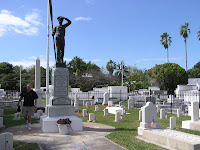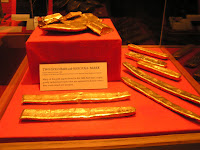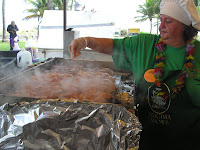Leaving our winter clothing in our car at the Omaha Nebraska airport on January 5th we flew to West Plam Beach airport where my college roommate and good friend Bill Lucas picked us up and brought us to his home in Boynton Beach, Florida.

.JPG) Pretty Nice.
Pretty Nice.


 From the photo of the hotel with Elaine in it, you begin to get the picture of the location of our place on South Beach and the art deco style. This next shot was taken from the fourth floor sun roof. There was a wonderful spa pool on the outside 4th-flkoor patio of which we partook most days.
From the photo of the hotel with Elaine in it, you begin to get the picture of the location of our place on South Beach and the art deco style. This next shot was taken from the fourth floor sun roof. There was a wonderful spa pool on the outside 4th-flkoor patio of which we partook most days.

As you can see, we were right accross from the beach, where we spent many days enjoying the warm sun and waters of South Beach and the views. This is the place where the "beautiful people" play. We felt like the Clampetts of the Beverly Hillbillies amongst all the young, svelte and often topless bodies. There is also a large gay population here and it was quite common to see men and men strolling hand in hand.

.JPG) South Beach and all of the Miami area is like living in another country, as most of the time, one hears a babble of forein tongues. Chief among them being Spanish, as this area took in many Cuban refugees from Castro's repressive regime. While one does not hear much about it, each year thousands still flee to Florida for the opportunities afforded them here. The Cubans that we met were all industrious and hard working. Many of those who came in their youth are very successful entrepreneurs. Florida's economy would not be what it is in this area without all of those hard-working folks. We also heard a lot of French, Portuguese, Italian and German being spoken on the beach. Many opeople from the province of Quebec, Canada come down to enjoy the warmth as we were. As I said, we were in the minority, being English speaking.
South Beach and all of the Miami area is like living in another country, as most of the time, one hears a babble of forein tongues. Chief among them being Spanish, as this area took in many Cuban refugees from Castro's repressive regime. While one does not hear much about it, each year thousands still flee to Florida for the opportunities afforded them here. The Cubans that we met were all industrious and hard working. Many of those who came in their youth are very successful entrepreneurs. Florida's economy would not be what it is in this area without all of those hard-working folks. We also heard a lot of French, Portuguese, Italian and German being spoken on the beach. Many opeople from the province of Quebec, Canada come down to enjoy the warmth as we were. As I said, we were in the minority, being English speaking.  Should you want to venture into Miami, there are plenty of busstops convienently located. the fare is a flat $1.50, with transfers costing 75 cents. We did go into Miami one day and found the busses to be clean and reliable. We took a cruise of the Miamiharbor area and saw the homes of the ultra rich and famous. Elizabeth Taylor, Shaquille O'Neill, former home of Frank Sinatra, etc. etc. ad nauseum. We also visited a massive shopping area right on the harbor. We are not much for shopping, but it was the only rainy day during our whole time in Florida and offered a diversion from staying in the time share.
Should you want to venture into Miami, there are plenty of busstops convienently located. the fare is a flat $1.50, with transfers costing 75 cents. We did go into Miami one day and found the busses to be clean and reliable. We took a cruise of the Miamiharbor area and saw the homes of the ultra rich and famous. Elizabeth Taylor, Shaquille O'Neill, former home of Frank Sinatra, etc. etc. ad nauseum. We also visited a massive shopping area right on the harbor. We are not much for shopping, but it was the only rainy day during our whole time in Florida and offered a diversion from staying in the time share.
Restaurants are in abundance, some reasonable and some pricey. Elaine had a conference many years ago in Miami Beach and heard about stone crabs and wished to eat some. There is a somewhat famous restaurant formerly known as "Joe's Crab Shack." Their specialty was and is stone crabs. As they have prospered, it is now "Joe's Crab House." They are located on South Beach. Their food is absolutely delicious. However, we knew it would be pricey, as the waiters (did not see any waitresses) all were wearing tuxedos, and this was at lunch time in 80 degree weather.
 With tip, we paid $76 for lunch for 2. Ouch! However, it really was delicious.
With tip, we paid $76 for lunch for 2. Ouch! However, it really was delicious..JPG)
.JPG) During January, South Beach celebrates art deco with an art deco festival right on Ocean Drive. The street is closed off for 2 days and various vendors set up food, jewelry, artwork, etc. booths.
During January, South Beach celebrates art deco with an art deco festival right on Ocean Drive. The street is closed off for 2 days and various vendors set up food, jewelry, artwork, etc. booths. .JPG)
.JPG)
.JPG)
.JPG)
http://www.miamibeachfl.gov/NEWCITY/cityhall/comm_gross.asp
As I was talking to the driver, Saul and family decided that they were hungry and exited the car. Driver said, want to ride? So, Elaine & I became Mr. And Mrs. Saul Gross (see sign on side of car). We even went by the reviewing stand and were announced to all as Mr & Mrs. Saul Gross. We waved to our adoring constituents. We rode around the are for a while in this car and thanked the driver for the unique experience.
.JPG)
While not a dog person, the festival did include an "Arf Deco" dog parade. Elaine took the photo, not me - I simply ignored these misguided people.
.JPG)
Bill Lucas retired from the Corps of Engineers. One of his friends, Rober, from the Corps (also retired) happened to be in Miami on his boat - a 42 footer.

Robert spends about 6 months of the year on his boat, cruising from home port in New Bern,. North Carolina to points south. He invited us to come on board for a 2 day cruise to the northern part of the Florida Keys. Couldn't turn down an opportunity like that. His wife, Judy, was also on board. We enjoyed getting to know them and had a wonderful time.
.JPG)
.JPG)

When one talks of the Florida Keys, one usually is referring to a series of sandy islands beginning at the south tip of Florida at Key Largo and ending at Key West. There are keys above this, acutally Miami Beach is a sand bar island and technically would be a key. As we left Miami harbor we cruised in the sheltered waters of the keys. In this part of the keys, the water is usually only 10 feet or less in depth. It was a sunny and warm day and we enjoyed the top deck area for our sunning. We anchored by Boca Chito Key, a small island just to the noth of Sand Key. We were treated to a wonderful supper and enjoyed an evening of conversation and libations. You can see by the photos, this is a spacious vessel. Three bedrooms below deck, bathroom with shower, full kitchen, living room, even their pet cat.

.JPG)
.JPG)
The sunset was stunningly beautiful.
.JPG)
After a relaxing sleep and a delicious breakfast, we took the small skiff and motored into Boca Chita to have a look around. This part of the Keys are part of Biscayne Bay National Park. Boca Chita is the site of a former lighthouse (everything is satellite controlled now). Robert has all sorts of GPS sytems and charts for navigation. Boca Chita has several old buildings formerly used for who knows what. They are all made of coral stone. One can camp there if you wish.

We spent about 4 hours cruising back to Miami, where we said our thanks to Robert and Judy for this experience.
After several more days on the beach, Bill picked us up and we returned to Boynton Beach for a couple days.
Then we were off to Key West. To get to Key West, one drives along US Highway 1 over a series of sandy islands beginning at Key Largo and ending 106 miles later at Key west. Key West is the southernmost point of the 48 contiguous states.(keys)


Some of the keys are miles long and others are only small dots raised above the high tide level. Between Pigeon Key and Big Pine Key one crosses the 7-mile bridge, one of the longer bridges in the world.

.JPG)
One interesting feature of the B & B was that each morning they would post the last day's low temperature for Key West and for each guests home town. You can see why we were smiling when we compare to Kearney's reading. You'll probably have to click on this one to read the temp.

Of course we had to waste away in Margarittaville while here. Ate at Jimmy Buffet's restaurant Jimmywas out.
Visted several watering holes. Bill is standing under a State of Virginia license plate with the word "Magic." This plate is Bill's, from when he lived in Virginia. Most of the bars have live bands or singers. 
Some interesting sites to visit are:

One famous tombstone reads: "I told you I was sick."
.JPG)
Throughout Key West one sees and hears chickens all over the place. Roosters crow round the clock. The first settlers brought them here for insect control; they interbred with fighting roosters brought from Cuba. A city ordinance bans any harassment of the chickens. The estimated number of these noisy critters is 2,000. Should you wish to adopt one for non-culinary purposes see: http://www.thechickenstore.com/




.JPG)

The estimated value of the treasure in 1985 was around $400,000,000. Once Mr. Fisher began retrieving the treasure, the state of Florida decided that they should own the treaure and not Mel. The US Federal Government, not to be left out, also said that they owned the treasure. Why the government of Spain never laid ownership claims, I don't know. Mr. Fisher told them to stuff off and took his case all the way to the US Supreme Court. The Court ruled that every last bit of treasure belonged to the finders and the state & Feds owned none of it. It warmed my heart to learn this. Getting treasure is not without risk, one of Mr. fishers sons died while salvaging another vessel.


Never quite getting my fill of old fortresses, a visit to Fort Zachary Taylor in Key West and Fort Jeffereson in the Dry Tortugas was on our agenda. Both forts were constructed in the same era as Forts Sumpter and Pulaski (see earlier blog on our 2007 SE USA trip.
Here's Zachary Taylor, named after our 12th president and hero of the Mexican War. The fort was only 1 of 3 in the South that remained under Federal control during the Civil War, AKA War between the States. Probably was too remote to bother with.
/div>

.JPG)
A visit to Key West would be incomplete without a daily trip to watch the sunset festival ay Mallory Square. The main idea is to watch the sun set. Elaine took a fabulous photo of one sunset.

http://www.catmankeywest.com/info.htm

.JPG)
.JPG)
.JPG)

Another island is the site of Fort Jefferson. I think this was the largest of the coast forts built during the 1840s. It is one of the other 2 southern forts that
remained in Union control during the 1861-1865 conflict between the North and South.
.JPG)
.JPG)
.JPG)
Around 1845, construction began on Fort Jefferson. Construction continued intermittently for the next 30 years, but never really was finished. It was abandoned in 1874. Like many of these coast forts, it never fired a shot in anger. In later years it became a bird sanctuary (1918); a National Monument (1935, and a Natinal Park (1992). About the only famous thing that happened here was the incarceration of Dr. Mudd after the Civil War. Dr. Mudd gain notariety because he happended to set the broken leg of John Wilkes Boothe (Abraham Lincoln's assassin) while Boothe was on the run. Poor guy didn't even know who Boothe was or what he had done. Times were harsh and he served his sentence at Fort Jefferson. When a yellow fever epidemic killed the post doctor and all of the nurses, Mudd was asked to help out. He did, and the epidemic just happened to wane. He received a Presidential Pardon for his humanitarian activities. Americans may remember Roger Mudd as a news reporter during the 1960s to the 1980s. He was a descendant of Dr. Mudd. The family still seeks to clear his name of any wrong doing, as he was only doing what any doctor would be expected to do. Today, Mr Boothe would have sued him if he had refused treatment, and Isuppose the gov't would have charged him with a crime for refusing treatment. Sometimes you just can't win.

.JPG)
.JPG)
After spending some time exploring the Fort, Elaine and I donned our snorkelling gear and spent a few hours in the clear and warm waters around the Fort's outer walls.
What a trip!
Leaving Key West with a great number of pleasant memories, we returned to Boynton Beach and spent a day or so at Bill's before flying back to the cold north country, where winter still held the land in its icy grip.
Next winter we plan to get out of Nebraska to a warmer clime again.

.JPG)
.JPG)
.JPG)
.JPG)

.JPG)
.JPG)